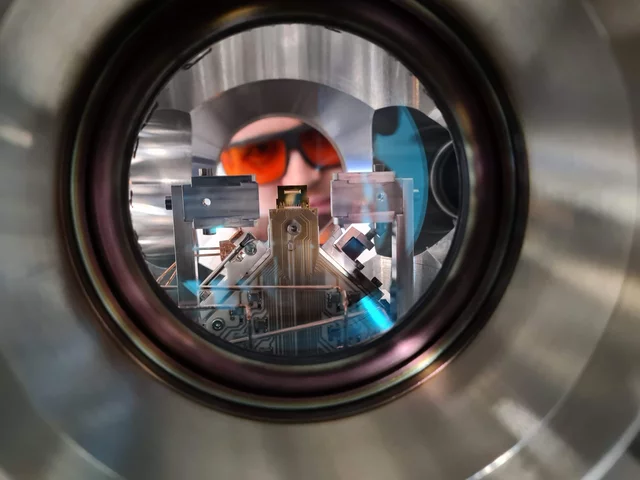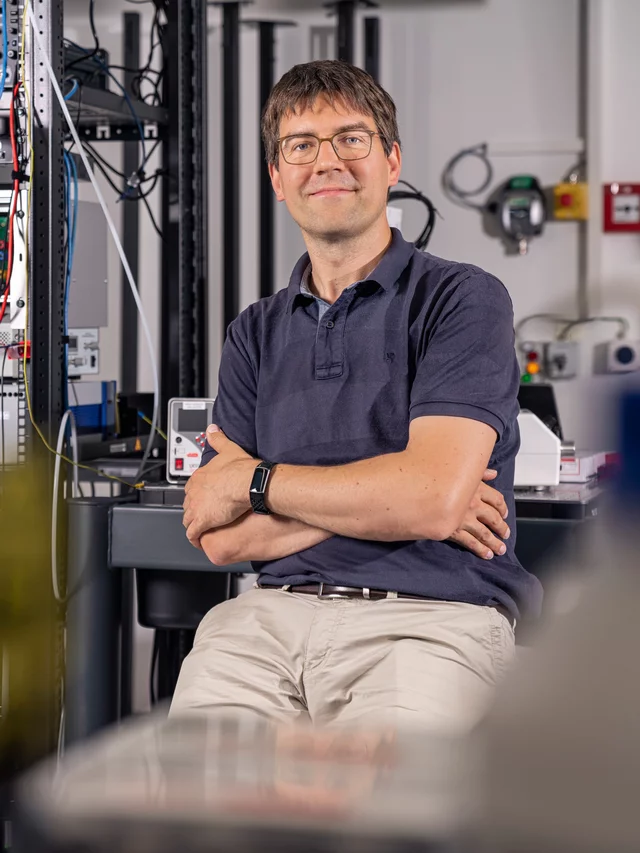Using quantum computers already today
Understanding how chemical reactions really happen at a quantum mechanical level is difficult. As advanced research infrastructures such as the Swiss hard X-ray free-electron laser SwissFEL enable new insights into the ultrafast changes that govern them, the data becomes too complicated to model classically. Here, simulations on quantum computers could help.
(Photo: Paul Scherrer Institut/Edgar Brucke)
(Photo: Paul Scherrer Institut/Markus Fischer)
Error-free quantum computers are still the subject of intense research. But the quantum objects used in them can already be applied to scientific simulations. "The central idea is to approach a computational problem differently – namely through direct mimicry of the quantum processes itself, instead of a step-by-step calculation," explains Cornelius Hempel, who leads the Ion Trap Quantum Computing group at PSI.
This approach could be useful at research infrastructures such as SwissFEL. Here, thanks to the very short pulses of extremely brilliant X-ray light, unprecedented levels of detail into ultrafast chemical processes and the quantum properties of the molecules involved in them are now possible. Yet making the most of these capabilities requires adequate computational tools to understand them.
As experimental capabilities advance to allow insights into more and more complex systems, simulating them on a classical computer becomes a challenge. “When we’re looking at how molecules behave in chemical reactions, we need to consider not only how the individual electrons of the constituent atoms behave, but also how their nuclei or atomic cores made out of protons and neutrons move and vibrate,” explains Hempel. “Computer simulations often focus just on the electrons, and even there reach their limits very quickly. Adding the atomic core to the mix makes them fail almost immediately and is impossible for most molecules.”
Hempel’s solution is a technique known as analogue quantum simulation. In this technique, researchers represent a problem that they don’t understand using a well-controlled quantum system that they do understand. "Because we carry it out on a quantum computer, the quantum process becomes far more accessible than in the actual chemical reaction itself,” says Hempel.
100 billion times slower than in nature
Hempel has now achieved a first success in this direction with his former team at the University of Sydney. With a trapped-ion quantum computer the researchers could reconstruct the essential part of an extremely fast quantum chemical reaction for the very first time.
While working as a principal investigator at the University of Sydney, Hempel, together with chemist Ivan Kassal, devised a research programme to simulate quantum phenomena, as they occur in chemical reactions with the goal of carrying them out on a quantum computer prototype that his team were building. Recently, their successful study was published in the journal Nature Chemistry.
In their study, the researchers focused on a specific phenomenon: so-called "conical intersections". In photochemical reactions, molecules transfer energy at lightning speed. In the process, exchange areas form between different energetic states of a molecule, which are called conical intersections – a name that derives from the conical shape in the energy landscape around which the reactions take place. Conical intersections are known throughout chemistry and serve as vital "energy funnels" between molecular states in reactions.
Since the 1950s, researchers have been working to directly observe such intersections in chemical dynamics. However, given the extremely fast time scales on which they occur – these processes are over within femtoseconds, or one millionth of one billionth, of a second – this is an extremely challenging task.
To observe how an energy wave packet behaves around a simulated conical intersection, the researchers used a single ion, which was controlled and measured using a complex and precisely orchestrated sequence of laser pulses. The mathematical model describing the conical intersection was finally translated to the ion system so that the ion could evolve equivalently to the simulated molecule around the intersection constructed in this way.
In this way, the researchers succeeded in slowing down the entire process by a factor of 100 billion and allowing for a measurement of the expected energy interactions in these structures for the very first time.
(Video: Sebastian Zentilomo)
Proof of concept with practical applications
On the one hand, the result and more complex future simulations can contribute to a deeper understanding of how molecules change on extremely fast time scales. This could help to better describe processes involving such molecules, such as smog formation, ozone depletion or the development of better materials for harnessing solar energy. In biology, too, these processes are of central importance. Human vision, for example, is based on an ultrafast photochemical reaction that passes through a conical intersection.
On the other hand, the result shows what quantum computers are already capable of today. "Our experiment really is a proof of concept," explains Cornelius Hempel. "It demonstrates an alternative approach to solving a problem from the field of chemistry that uses quantum computers in a way that is already feasible, albeit not yet at a scale that allows for anything as complex as modelling human vision."
Quantum simulations in proximity to large research facilities
Hempel, who is researching the development of scaled-up, error-free quantum computers with his team, plans to further develop this initial proof-of-concept study and to carry out quantum simulations at PSI in the near future together with colleagues working on other quantum computing platforms: “Our method not only works with trapped ions, but also on other types of quantum computers, which are also being researched at PSI." Within the Laboratory for Nano and Quantum technologies, Hempel and colleagues are now specifically trying to advance these technologies with the goal of complementing experiments at PSI’s large-research facilities.
At SwissFEL, for example, structural biologists are studying the conical intersection that underlies human vision. With the very short pulses of X-ray light generated by the SwissFEL, extremely fast processes in which photons are absorbed and converted into biological signals can be studied. Hempel is confident that the close collaboration with research groups from biology and chemistry at PSI, who are working experimentally on biological receptors in which conical intersections play an integral role, will be a great advantage.
"We have shown that analogue quantum computing works for simple chemical reactions. The next step will be to scale up our devices to allow us to simulate more complex molecules such as these photoreceptors. With the input of our colleagues, we can hopefully try to push our simulations into a regime where they begin to help interpret experimental data. That would be tremendously exciting,” he adds.
About the Quantum Computing Hub
The Quantum Computing Hub was founded two years ago by ETH Zurich and the Paul Scherrer Institute as a jointly operated research facility. At the Hub, researchers are working on two different concepts of quantum computers: qubits made of superconducting circuits and qubits stored in trapped ions. The first approach uses circuits made of superconducting materials – that is, materials that conduct electricity without electrical resistance and exhibit properties at extremely cold temperatures that can be used to store qubits. In the second approach, on the other hand, individual ions are trapped in vacuum apparatus and manipulated using laser light. The two methods are currently the most advanced architectures for building a quantum computer and therefore also the starting point for the research at the Hub.
Text: Paul Scherrer Institut/Benjamin A. Senn and Miriam Arrell based on a press release from the University of Sydney.

